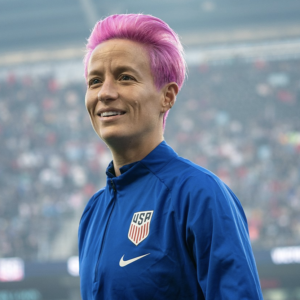Players on the U.S. women’s national soccer team are paid more than their counterparts on the men’s team. But Megan Rapinoe isn’t letting facts stand in the way of her p.r. campaign to pressure the United States Soccer Federation (USSF) into increasing her salary.
In March, the gold medalist and two-time World Cup Champion complained to Congress and to President Joe Biden that she is a victim of pay discrimination. Later this month, she’ll take her case to the court of public opinion in a new documentary, LFG, that will begin streaming on HBOMax.
Unfortunately for Rapinoe, the only court of law to rule on the matter found her claims wanting.
In 2019, Rapinoe and her teammates sued USSF in California federal court, seeking more than $66 million in damages for alleged wage discrimination and discriminatory working conditions. The court found sufficient evidence to allow the players to proceed with their claims of unequal travel and hotel accommodations, medical support, training, and other support services. But it dismissed the players’ claims of pay discrimination, finding that the women’s team earned more than the men’s team on both a cumulative and per-game basis.
It turns out, the Women’s National Team earned approximately $24 million overall; the Men’s National Team earned only $18 million. The average take per game was $220,747 for the women’s team, compared to $212,639 for the men’s team. And while the individual female plaintiffs made an average of $11,356 to $17,416 per game, the four highest-paid male players made an average of $10,360 to $13,964 per game.
Facts are stubborn things. And so, Rapinoe and her teammates argued that, even though they received more money than their male counterparts, they were, nevertheless, victims of discrimination. Why? Because they would have earned even more had they been paid under the men’s pay structure, which offers higher bonuses.
The collective bargaining agreement for the men’s team is an incentive-based, pay-to-play contract, under which only players who are selected for training camps or particular competitions have a chance to earn bonuses. The court found that the women’s team, in fact, rejected an offer to be paid under the same structure as the men, opting instead for higher base pay and greater stability in the form of yearly salaries, paid irrespective of training camps attended or games played.
Late last year, plaintiffs and USSF settled the unequal working conditions portion of the case, with the federation agreeing to provide the female players with travel arrangements, hotel accommodations, staffing, and venues on par with the male athletes. Good for the women’s team. They deserve it. And that should be the end of the matter.
In America today, however, victim status is the coin of the realm. And so Rapinoe and her merry band of warriors fight on, addicted to fame, praised by celebrities such as Jamie Lee Curtis and politicians like Vice President Kamala Harris, and feted by elites in Hollywood and Washington alike.
In April, the players appealed the trial court’s pay discrimination ruling to the U.S. Court of Appeals for the 9th Circuit, pressuring USSF to mediate the baseless claims ahead of the summer Olympics in Japan. And earlier this month, 13 Democratic senators sponsored a bill to withhold federal funds from the 2026 FIFA World Cup unless USSF increases pay for the women’s team. If enacted, the Give Our Athletes Level Salaries (GOALS) Act would prohibit funding for USSF, FIFA, and for host cities and state or local organizations assisting with the event, which is set to be hosted jointly by the U.S., Canada, and Mexico.
Will USSF capitulate to Rapinoe’s demands in order to avoid a sideshow in Tokyo next month and to prevent the loss of its World Cup funding? Quite possibly. But don’t let Megan Rapinoe fool you: A victim of sex discrimination, she is not.

